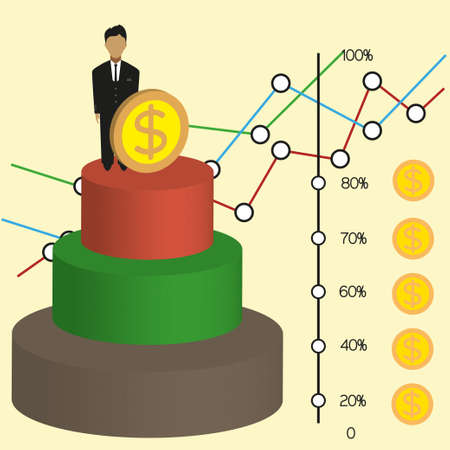1. Introduction to Bull and Bear Markets
When it comes to investing, understanding market trends is crucial. Two of the most commonly discussed market conditions are bull and bear markets. These terms describe the general direction of stock prices and can significantly impact investors’ decisions and economic stability.
What Are Bull and Bear Markets?
A bull market refers to a period when stock prices are rising or expected to rise. Typically, a market is considered bullish when stock prices increase by at least 20% from recent lows. This period is often characterized by investor confidence, strong economic indicators, and increased corporate profits.
On the other hand, a bear market occurs when stock prices decline by 20% or more from recent highs. Investors tend to lose confidence, economic growth slows down, and businesses may struggle with lower revenues.
Key Characteristics of Bull and Bear Markets
| Market Type | Definition | Investor Sentiment | Economic Indicators |
|---|---|---|---|
| Bull Market | Stock prices rising by 20% or more | Optimistic and confident | Strong GDP growth, low unemployment, high corporate earnings |
| Bear Market | Stock prices declining by 20% or more | Pessimistic and fearful | Slowing GDP growth, high unemployment, declining corporate earnings |
Why Do These Markets Matter?
Bull and bear markets play a crucial role in shaping investment strategies. Investors make decisions based on market trends, adjusting their portfolios to minimize risks or maximize gains. A bull market often encourages more aggressive investing, while a bear market leads to cautious approaches like holding cash or investing in defensive assets.
(1) Impact on the Economy
- Bull markets: Typically coincide with economic expansion, job creation, and increased consumer spending.
- Bear markets: Often align with recessions, layoffs, and reduced consumer confidence.
(2) Impact on Investors
- Bull markets: Encourage higher-risk investments as stocks generally perform well.
- Bear markets: Lead investors to seek safer options such as bonds or gold.
The Importance of Recognizing Market Trends
Understanding whether the market is bullish or bearish helps investors make informed decisions. By recognizing key indicators early, individuals can adjust their strategies to protect wealth during downturns and capitalize on opportunities during upswings.
(1) Long-Term vs. Short-Term Perspectives
While short-term fluctuations are common, long-term investors focus on overall trends rather than daily price movements.
(2) Diversification Strategies
A well-diversified portfolio can help mitigate risks during bear markets while still benefiting from bull market growth.
By grasping these fundamental concepts, investors can navigate financial markets more effectively and build resilient investment strategies for the future.
2. Key Indicators of Market Trends
Understanding the stock market requires paying close attention to key economic indicators that signal whether we are in a bull or bear market. These indicators help investors make informed decisions by providing insights into the overall health of the economy and financial markets. Below, we explore some of the most critical indicators.
Gross Domestic Product (GDP) Growth
GDP measures the total economic output of a country. Strong GDP growth generally indicates a healthy economy, which supports rising stock prices and a bull market. Conversely, slow or negative GDP growth may signal economic trouble and contribute to a bear market.
| GDP Growth Rate | Market Implication |
|---|---|
| 3% or higher | Bull market likely |
| 0% – 2% | Neutral to slightly bullish |
| Negative growth | Possible bear market |
Unemployment Rates
The unemployment rate is a crucial indicator of economic stability. Low unemployment means more people have jobs, leading to higher consumer spending and corporate profits, which can drive a bull market. High unemployment, on the other hand, can reduce consumer confidence and lead to declining stock prices.
(1) Low Unemployment (Below 4%)
A strong labor market often correlates with economic expansion and rising stock prices.
(2) Moderate Unemployment (4%-6%)
This range suggests a stable economy but may indicate slowing growth if it trends upward.
(3) High Unemployment (Above 6%)
A sign of economic distress, high unemployment can contribute to lower investor confidence and a potential bear market.
Corporate Earnings
Earnings reports from major companies provide insight into business profitability and economic conditions. When corporate earnings are strong, stock prices tend to rise as investors gain confidence in future growth. Declining earnings can trigger sell-offs and contribute to a bearish outlook.
(1) Rising Earnings Reports
If companies consistently report higher profits, this can signal strong economic performance and fuel a bull market.
(2) Declining Earnings Reports
If corporate profits decrease over multiple quarters, it may indicate economic weakness and contribute to bearish sentiment.
Investor Sentiment
The overall mood of investors plays a significant role in market direction. If investors are optimistic, they are more likely to buy stocks, pushing prices higher. If fear dominates the market, selling pressure can drive prices down.
(1) Bullish Sentiment
A high level of optimism often leads to increased buying activity and higher stock prices.
(2) Bearish Sentiment
Pessimism among investors can result in widespread selling and declining markets.
(3) Neutral Sentiment
If investors are uncertain about the economy, markets may remain volatile with no clear trend.
By monitoring these key indicators—GDP growth, unemployment rates, corporate earnings, and investor sentiment—investors can better understand market trends and position themselves accordingly for both bull and bear markets.

3. Historical Trends and Market Cycles
Understanding historical market trends can help investors recognize patterns and make informed decisions. By analyzing past bull and bear markets, we can identify key events that triggered these shifts and gain insights into how markets react to economic conditions.
Key Historical Bull and Bear Markets
Markets have experienced multiple cycles of expansion (bull markets) and contraction (bear markets). Below are some significant historical market trends:
| Market Cycle | Time Period | Main Triggers | Impact on Economy |
|---|---|---|---|
| The Great Depression (Bear) | 1929 – Early 1930s | Stock market crash, banking failures, reduced consumer spending | Mass unemployment, deflation, severe economic downturn |
| The Post-WWII Boom (Bull) | 1945 – 1960s | Economic recovery, industrial growth, rising consumer demand | Sustained growth, increased wealth, strong labor market |
| The Dot-Com Bubble (Bear) | 2000 – 2002 | Bursting of tech stock speculation bubble | Stock market decline, job losses in the tech sector |
| The 2009-2020 Bull Market | 2009 – 2020 | Easing monetary policy, corporate earnings growth, technological advancements | Sustained economic expansion, record-high stock prices |
| The COVID-19 Crash (Bear) | Early 2020 | Pandemic-related shutdowns, economic uncertainty, supply chain disruptions | Sharp market drop followed by rapid recovery due to stimulus measures |
Main Factors Behind Market Shifts
Bull and bear markets are driven by various factors. Here are some of the most common triggers:
(1) Economic Indicators
- Bull Markets: Strong GDP growth, low unemployment, rising corporate profits.
- Bear Markets: Economic recessions, high unemployment rates, declining business investments.
(2) Interest Rates and Monetary Policy
- Bull Markets: Low interest rates encourage borrowing and investment.
- Bear Markets: High interest rates can slow down economic activity and reduce consumer spending.
(3) Global Events and Crises
- Bull Markets: Periods of stability and innovation drive long-term growth.
- Bear Markets: Wars, pandemics, financial crises disrupt economic confidence.
(4) Investor Sentiment and Speculation
- Bull Markets: Optimism leads to higher risk-taking and asset appreciation.
- Bear Markets:: Fear drives sell-offs and market corrections.
The Importance of Recognizing Market Cycles
No bull or bear market lasts forever. Understanding past trends helps investors manage risks and adjust strategies accordingly. While history doesn’t guarantee future outcomes, recognizing patterns can provide valuable guidance for making informed investment decisions.
4. Strategies for Navigating Market Conditions
Understanding how to navigate both bull and bear markets is essential for long-term investment success. By implementing effective strategies such as diversification, risk management, and proper asset allocation, investors can better position themselves to withstand market fluctuations.
Diversification: Spreading Risk Across Assets
Diversification helps reduce the impact of a single asset’s poor performance on an overall portfolio. A well-diversified portfolio includes different asset classes, sectors, and geographical regions.
| Asset Class | Role in Portfolio |
|---|---|
| Stocks | Growth potential, higher risk |
| Bonds | Stability, income generation |
| Real Estate | Tangible asset, inflation hedge |
| Commodities | Diversification during economic uncertainty |
| Cash & Cash Equivalents | Liquidity and capital preservation |
Risk Management: Protecting Your Investments
(1) Setting Stop-Loss Orders
A stop-loss order helps limit potential losses by automatically selling a stock when it reaches a predetermined price. This is especially useful in bear markets to protect against further declines.
(2) Rebalancing Portfolio Regularly
Maket fluctuations can shift your asset allocation away from your intended strategy. Periodically rebalancing ensures that your portfolio maintains the right level of risk exposure.
(3) Hedging with Defensive Assets
Certain assets, such as gold or defensive stocks (e.g., utilities and consumer staples), tend to perform well during downturns. Allocating a portion of your portfolio to these assets can help mitigate losses in bear markets.
Asset Allocation: Adjusting for Market Cycles
(1) Bull Market Strategy: Maximizing Growth
Bull markets present opportunities for higher returns. Investors may consider increasing their exposure to equities, growth stocks, and sectors that thrive in expansionary periods, such as technology and consumer discretionary.
(2) Bear Market Strategy: Capital Preservation
During bear markets, preserving capital becomes a priority. Shifting towards bonds, dividend-paying stocks, and cash equivalents can provide stability while reducing downside risk.
(3) Dollar-Cost Averaging (DCA)
DCA involves investing a fixed amount at regular intervals regardless of market conditions. This strategy reduces the impact of short-term volatility and lowers the average cost per share over time.
Navigating market conditions requires a disciplined approach that balances risk and reward. By applying these strategies, investors can maintain financial stability while positioning themselves for long-term success.
5. The Role of Government Policies and Global Events
Market conditions are heavily influenced by government policies and global events. Understanding how fiscal policies, interest rates, inflation, and major world events impact the stock market can help investors make informed decisions.
Fiscal Policies and Their Impact
Government spending and taxation play a significant role in shaping market trends. When governments increase spending on infrastructure or social programs, it can stimulate economic growth and drive a bull market. On the other hand, higher taxes may slow down business investments, leading to bearish conditions.
Interest Rates and Market Reactions
The Federal Reserve sets interest rates to control inflation and economic growth. Interest rate changes influence borrowing costs for businesses and consumers, directly impacting stock prices.
| Interest Rate Change | Market Impact |
|---|---|
| Rate Increase | Higher borrowing costs, reduced corporate profits, potential bear market |
| Rate Decrease | Lower borrowing costs, increased investments, potential bull market |
Inflation’s Role in Market Trends
Moderate inflation is typically associated with economic expansion. However, when inflation rises too quickly, it reduces consumer purchasing power and increases business costs, leading to market volatility.
(1) High Inflation Effects
- Erodes consumer purchasing power
- Lowers corporate profit margins
- Makes borrowing more expensive
(2) Low Inflation Effects
- Keeps consumer prices stable
- Encourages business investments
- Supports long-term market growth
The Influence of Global Events
Pandemics, wars, trade agreements, and geopolitical tensions can create uncertainty in financial markets. Investors often react strongly to global events, causing sharp fluctuations in stock prices.
(1) Economic Crises
Panic-driven sell-offs during crises can lead to rapid downturns, while recovery efforts may signal new bull markets.
(2) Political Shifts
Elections and policy changes can impact investor confidence and sector performance.
(3) Natural Disasters & Pandemics
Sectors such as healthcare and technology may see gains during crises, while travel and hospitality industries suffer losses.
Navigating the stock market requires an awareness of these key factors. By monitoring government policies and global developments, investors can better anticipate shifts in bull and bear markets.


